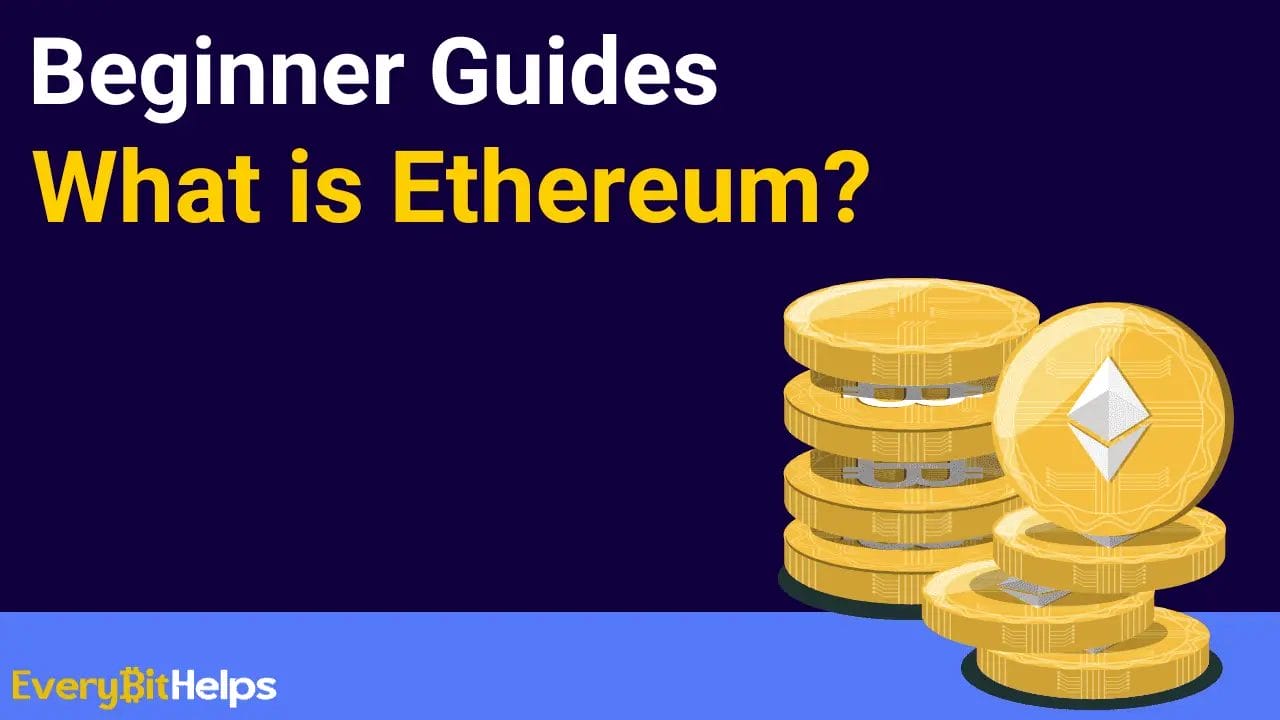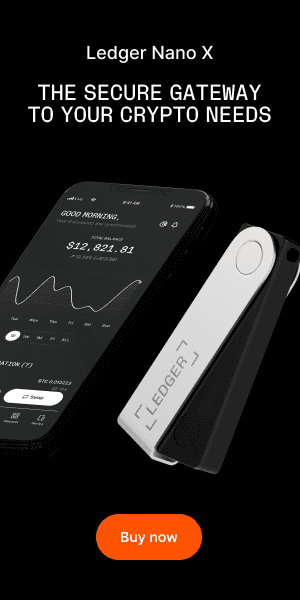In this beginner’s guide, we delve into the world of Ethereum, the second-largest cryptocurrency in the market. We aim to simplify the core concepts of Ethereum, helping you understand its purpose, functionality, and real-world implications.
Ethereum is an innovative, decentralized platform that lets users create and use smart contracts – digital agreements on a safe, open blockchain network. This cutting-edge technology enables developers to build and deploy decentralized applications (dApps) and offers users a secure and transparent way to conduct transactions.
Let’s explore the basics of Ethereum together, learning how it works and discovering the many ways it’s changing various industries worldwide.
What is Ethereum?
Ethereum is a decentralized, open-source platform that enables the creation and execution of smart contracts and distributed applications (Dapps) without the need for a central authority. It uses blockchain technology, similar to Bitcoin, but offers a more extensive range of features and capabilities.
At the heart of Ethereum is its native cryptocurrency, Ether (ETH), which is used for transactions and as a store of value. Developers can design, deploy, and run Dapps on a peer-to-peer network of nodes, enabling users to interact with these applications securely and transparently.
Ethereum’s smart contracts are digital agreements that automatically execute when predefined conditions are met. This feature allows for the creation of trustless, decentralized systems that can automate processes and reduce the need for intermediaries.
By providing a versatile platform for decentralized applications, Ethereum has the potential to revolutionize industries such as finance, supply chain, and even governance, making transactions and contracts more secure, transparent, and efficient across the web. Its innovative approach to decentralization continues to attract developers and users alike, shaping the future of digital interactions.

Ethereum History
- Ethereum Founding (2013-2014): Ethereum’s history began in 2013 when Vitalik Buterin, a computer scientist, published his Ethereum Whitepaper detailing the power of smart contracts and potential applications.
- Development (2014): Buterin and his team worked on the Ethereum network, developing its core components and setting the stage for its launch.
- Ethereum Launch (2015): Ethereum was officially launched in July 2015.
- The DAO Event (2016): A significant event called “The DAO” occurred, where a decentralized autonomous organization (DAO) built on Ethereum was hacked. Leading to a controversial fork and the creation of Ethereum Classic.
- Ethereum 2.0 (2022 – 2023): A new version of Ethereum, called Ethereum 2.0, was developed to enhance performance, scalability, and efficiency. It introduces features like sharding and cross-chain communication.
- Continued Development (Present): Ethereum continues to grow rapidly, with various applications being built, such as cryptocurrency trading, gaming, NFTs and financial services. Its native cryptocurrency, Ether (ETH), has also gained significant value.
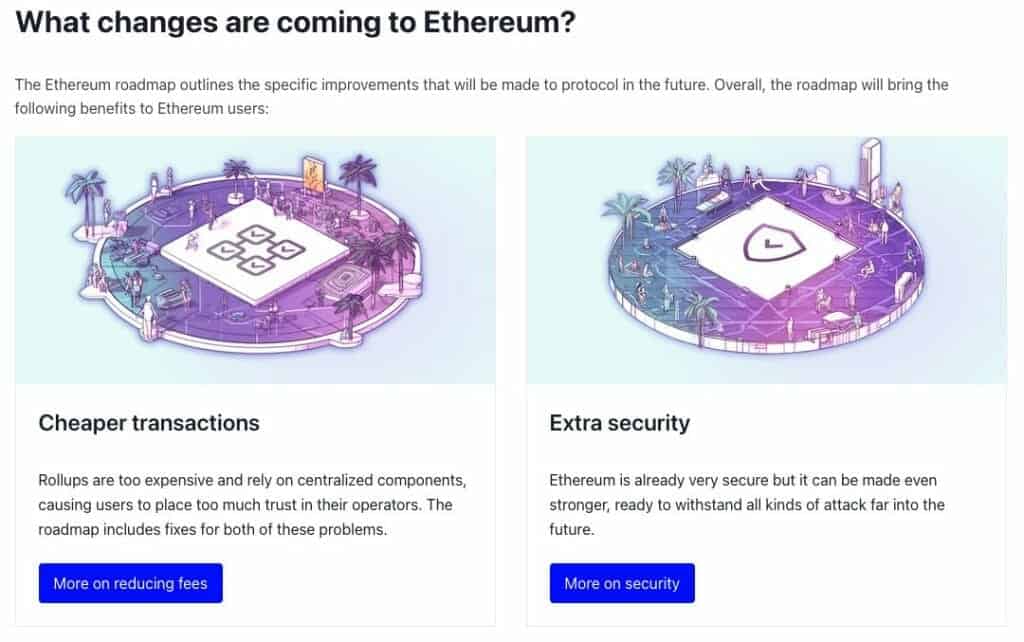
Who are the Founders of Ethereum?
Ethereum was conceived by a group of five individuals. The key figure among them is programmer Vitalik Buterin, who first conceived the idea in 2013. The additional founders are Gavin Wood, Charles Hoskinson, Anthony Di Iorio, and Joseph Lubin.
Buterin was the one who envisioned the platform, while the other founders had their unique contributions. Gavin Wood, for example, was the one who wrote the Ethereum Yellow Paper that formalized the Ethereum Virtual Machine (EVM).
Charles Hoskinson contributed to the strategic development and legal framework of Ethereum. Anthony Di Iorio provided financial resources during the early days of Ethereum, and Joseph Lubin went on to found ConsenSys. This blockchain production studio develops decentralized software services on the Ethereum blockchain.
How Does Ethereum Work?
Ethereum is a decentralized platform allowing users to create and run smart contracts and apps without a central authority. Built on blockchain technology, it relies on computers called nodes to validate and record transactions. Ethereum uses a proof-of-stake system, where participants called validators “stake” Ether to confirm transactions and create new blocks.
This shift to proof-of-stake makes Ethereum more energy-efficient and secure, offering a transparent, user-friendly environment for digital agreements and decentralized applications.
How is the Ethereum Network Secured?
The Ethereum network is secured under the Proof of Stake (PoS) consensus mechanism. Ethereum switched to its PoS mechanism in 2022, as it was deemed more secure, less energy-intensive, and more effective for implementing new scaling solutions, in contrast to the previous Proof of Work (PoW) architecture.
Under the PoS mechanism, validators are chosen based on their stake in the network. The larger the stake a validator holds, the more likely it will be chosen to add a new block to the blockchain. This process incentivizes validators to act honestly, as their financial stake in the network can be forfeited or reduced if they attempt to manipulate the system or act maliciously.
In the PoS mechanism, a single validator is chosen from the total validator set to propose a block in each slot. This selection can be computed using a publicly known function, and it’s possible for an adversary to identify the next block proposer slightly in advance of their block proposal. However, the security measures in place make it challenging for an attacker to exploit this information.
The PoS consensus mechanism, therefore, strengthens the security of the Ethereum network by making the process of adding new blocks dependent on validators’ stakes. The financial risk associated with attempting to manipulate the system is designed to deter malicious actions and maintain the integrity of the network.

Ethereum Smart Contracts
Smart Contracts are self-executing computer programs on blockchain networks like Ethereum. They automatically carry out the terms of an agreement between parties when certain conditions are fulfilled. This is all implemented without the need for human intervention.
Instead of traditional legal language, smart contracts use code to define rules and consequences. This eliminates the need for middlemen and lowers the risk of fraud or disputes. Smart contracts can also be used for various applications, such as financial transactions, property ownership, or supply chain management, offering a more efficient, transparent, and secure way to conduct business.
Think of it as Google Play Store, where you can create your own applications. As with Google Play Store, Ethereum also has a defined set of regulations which are not subject to change. All users must abide by these rules when creating their programs on Ethereum.
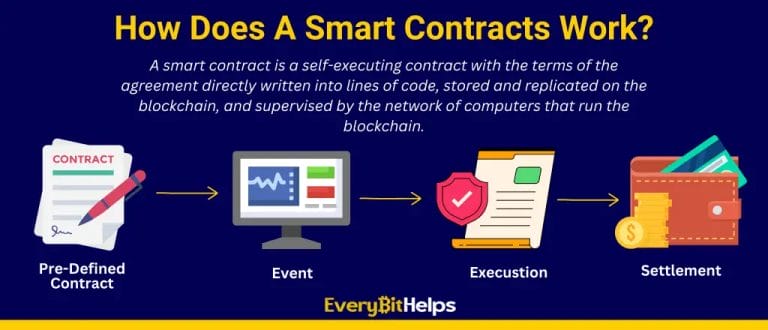
Ethereum Security
Like Bitcoin, Ethereum has a vast network of validators. Ethereum runs on 2000+ nodes worldwide, making it impossible to attack the network. Even if a few nodes are attacked, the network will continue to work seamlessly because of the network validators.
Ethereum has defined security protocols for building decentralized apps on the platform, which are considered the best on the blockchain. Despite cut-throat competition and constant innovation in smart contract blockchains, Ethereum remains the #1 choice for developers.
What is Ether (ETH)?
Ether (ETH) is the digital currency of the Ethereum network, playing a vital role in facilitating operations on this platform. Think of it as the network’s lifeblood or “fuel” that keeps the system running. It’s utilized as a form of payment by users to the network contributors who carry out their requested operations.
It’s important to note that Ether is a significant player in the world of cryptocurrencies, holding the position of the second-largest virtual currency by market capitalization, just behind Bitcoin.
Ethereum Move from Proof of Work to Proof of Stake
Ethereum faced significant criticism due to its substantial carbon footprint caused by the energy-intensive Proof of Work consensus mechanism. However, in September 2022, Ethereum transitioned to a Proof of Stake model, dramatically decreasing energy consumption by 99.95%. This pivotal change made Ethereum more environmentally friendly and sustainable while maintaining a highly decentralized network.
What is Proof of Stake?
Proof of Stake (PoS) is a consensus mechanism blockchain networks use to validate and verify new cryptocurrency transactions. Proof of Stake is an alternative to Proof of Work, which is used in Bitcoin.
PoS protocols select validators based on the proportion of their holdings in the associated cryptocurrency instead of relying on computational power like Proof of Work. The main goal of PoS is to avoid the high computational costs and energy consumption associated with Proof of Work schemes.
By staking cryptocurrency, participants help secure the network and can potentially earn rewards.
Ethereum Annualized Energy Consumption for POS
Ethereum’s annual energy consumption is a critical metric that illustrates the energy efficiency of the network. The Ethereum network has transitioned from a Proof of Work (PoW) system to a Proof of Stake (PoS) system. This transition is significant because PoS is expected to reduce Ethereum’s energy consumption drastically.
The researcher Carl Beekhuizen from the Ethereum Foundation has suggested that Ethereum’s energy usage will decrease by 99.95% once the network fully transitions to PoS from PoW. This indicates that the switch to PoS will make Ethereum much more energy-efficient.
The primary reason for Ethereum shifting to PoS is to cut energy consumption and enhance scalability. PoS demands significantly less computing power, thereby making it more energy-efficient than PoW. It also enables faster transaction times and lowers the risk of 51% attacks.
| Annual Energy Consumption (TWh) | Compared to PoS Ethereum | Sources | |
|---|---|---|---|
| Global Data Centers | 200 | 77,000x | source↗ |
| Gold mining | 131 | 50,000x | source↗ |
| Bitcoin | 131 | 50,000x | source↗ |
| PoW Ethereum | 78 | 30,000x | source↗ |
| Youtube (direct only) | 12 | 4600x | source↗ |
| Gaming in USA | 34 | 13,000x | source↗ |
| Netflix | 0.451 | 173x | source↗ |
| PayPal | 0.26 | 100x | source↗ |
| AirBnB | 0.02 | 8x | source↗ |
| PoS Ethereum | 0.0026 | 1x | source↗ |
What can you do on Ethereum?
Ethereum is a decentralized platform that enables developers to build and deploy a wide range of applications that make use of blockchain technology and smart contracts. Among these applications are DApps (Decentralized Applications), DAOs (Decentralized Autonomous Organizations), DeFi (Decentralized Finance), and NFTs (Non-Fungible Tokens). Each of these components represents both an application of Ethereum’s capabilities and a use case of the platform.
Decentralized Applications (dApps)
Decentralized Applications, often abbreviated as dApps, are digital applications that run their backend code on a decentralized network rather than on a centralized server. This decentralization makes dApps inherently different from traditional applications, which typically depend on a central authority or server to function.
On Ethereum, dApps utilize smart contracts as their backend code. A smart contract is a self-executing contract where the terms of agreement are written into code and stored on the Ethereum blockchain. Smart contracts allow dApps to function autonomously, with the contract’s rules being transparent and visible to all network participants. They execute exactly according to their defined rules, providing a trustless environment.
These smart contracts interact with the frontend of the dApps through APIs, such as the JSON-RPC layer used in Ethereum-based applications, allowing users to interact with the blockchain.
One example of the utilization of dApps is in Decentralized Finance (DeFi), a network of financial applications that are built on public blockchains like Ethereum. These dApps use smart contracts to replicate and automate financial services in a trustless and decentralized manner.
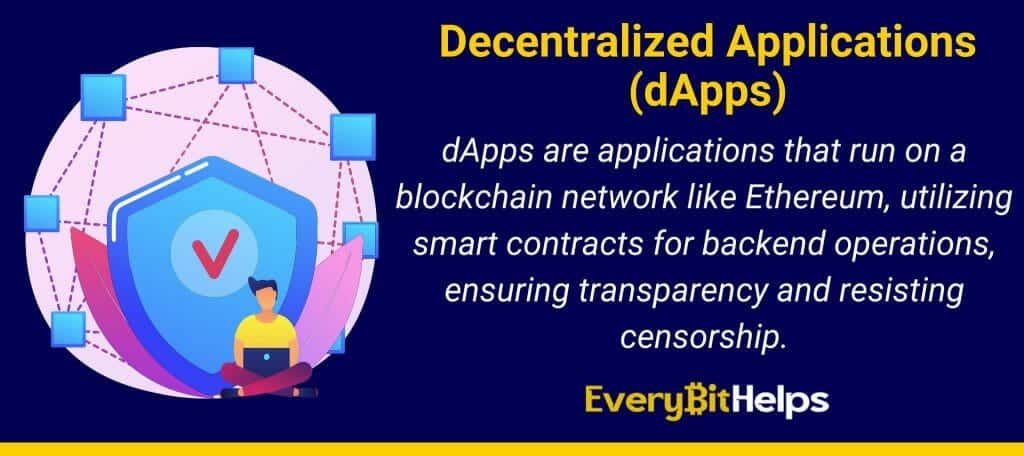
Decentralized Finance (DeFi)
Decentralized Finance, commonly known as DeFi, is a broad term encompassing various financial applications in the blockchain or cryptocurrency domain. Its main goal is to disrupt traditional financial intermediaries by providing services typically offered by banks, such as earning interest, lending, borrowing, buying insurance, trading derivatives, and more, but without the need for third parties, thus making transactions faster and paperless.
DeFi on Ethereum holds a significant place due to the platform’s inherent properties. Ethereum, with its smart contract functionality, serves as an excellent foundation for DeFi applications. It allows the creation of complex programmable transactions, and these smart contracts are used to build decentralized applications (DApps) that provide DeFi services. No single entity owns Ethereum or the smart contracts deployed on it, which ensures a level playing field for everyone, promoting fairness and open access.
DeFi products, which include decentralized exchanges, lending protocols, and synthetic derivatives, all use Ethereum as a common language, enhancing their interoperability. This means they can interact seamlessly with each other, creating an integrated financial ecosystem.
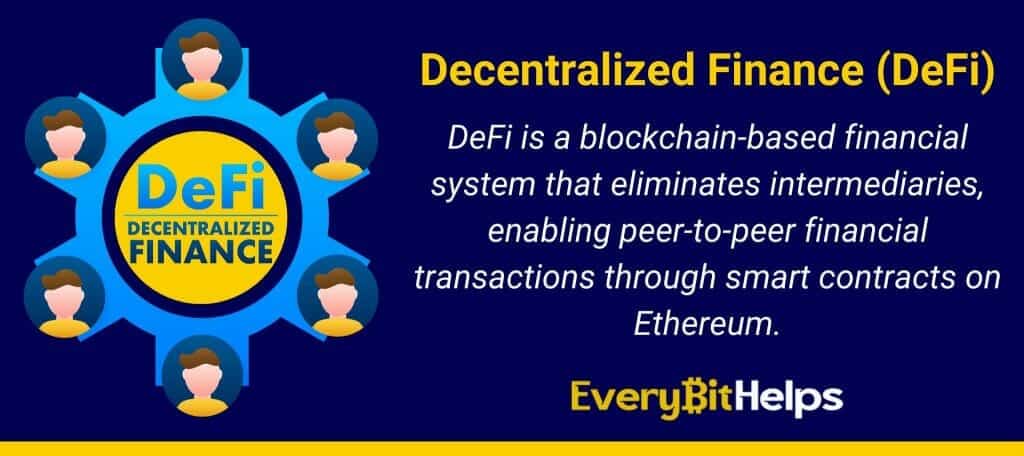
Decentralized Autonomous Organizations (DAOs)
A Decentralized Autonomous Organization, commonly referred to as a DAO, is an organization that is owned collectively and governed by blockchain technology. It operates towards achieving shared goals, and it allows people from across the globe to work together without needing to place trust in a single leader to manage funds or operations.
In essence, DAOs represent a radical shift from traditional top-down organizational structures to a bottom-up approach featuring no central authority. Members of a DAO possess tokens that represent their stake in the organization, and these tokens allow members to vote on initiatives and key decisions, enabling democratic governance.
One of the main advantages of a DAO is its transparency. All of a DAO’s financial transactions and rules are recorded on the blockchain, which anyone can verify. This transparency is further enhanced by the use of smart contracts – programmable contracts with predefined rules for execution – which allow DAOs to handle financial transactions without the need for a third party, thereby reducing the risk of manipulation or fraud.
The concept of DAOs was introduced as part of the Ethereum project, as Ethereum’s smart contract functionality provided an ideal environment for creating and managing DAOs. However, it’s crucial to note that once a DAO’s rules are deployed to the Ethereum blockchain, they become difficult to change. This characteristic, along with other complexities, can sometimes pose challenges.
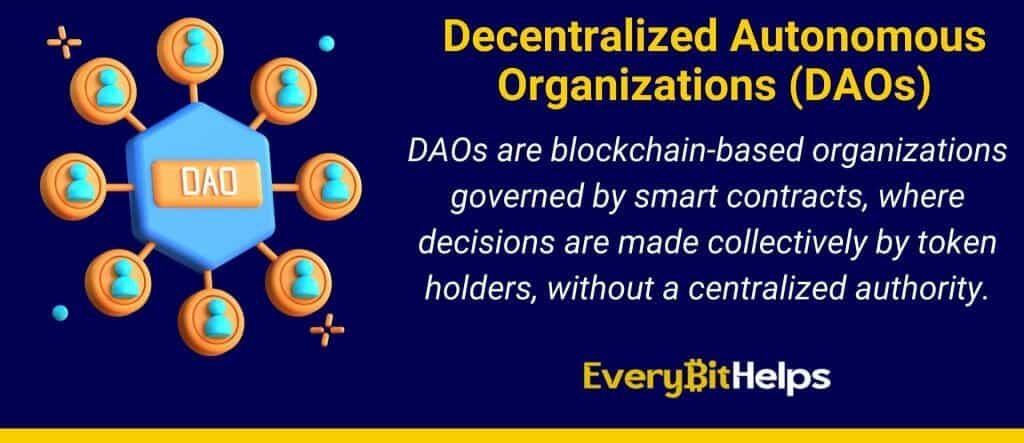
Non-Fungible Tokens (NFTs)
Non-Fungible Tokens, or NFTs, are unique cryptographic assets that exist on a blockchain, such as Ethereum. The term “non-fungible” refers to the token’s uniqueness, unlike “fungible” assets like Bitcoin or Ethereum coins, which are identical and interchangeable.
NFTs can be seen as digital certificates of ownership that attest to the authenticity and uniqueness of both digital and real-world items. They can represent various objects or content, including digital art, real estate, music, etc.
The key characteristic of an NFT is its uniqueness, which is encoded in its data and cannot be replicated. The ownership information of an NFT, along with its transaction history, is recorded on the blockchain, providing a transparent and immutable record. This ensures the authenticity of the asset and allows NFTs to be bought, sold, and traded in a transparent and secure manner.
Ethereum’s blockchain plays a crucial role in the world of NFTs as it provides the platform upon which most NFTs are created and transacted. Ethereum’s smart contract functionality allows for creation of unique, programmable tokens, making it ideal for NFTs.
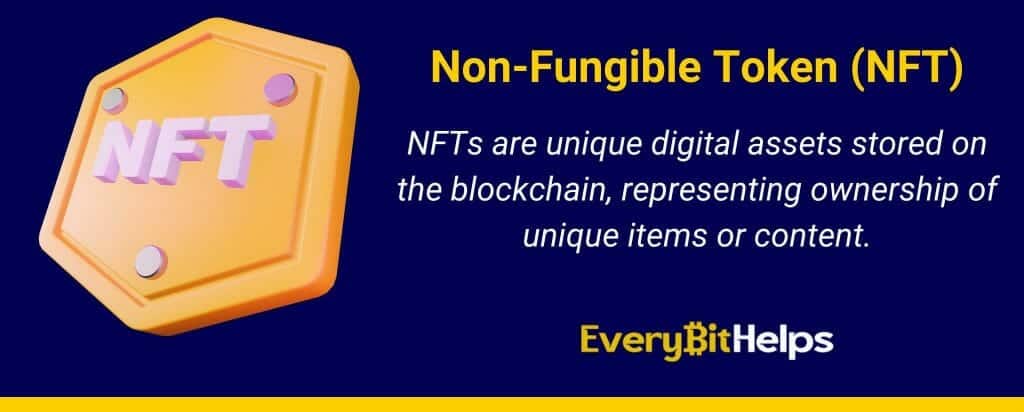
Types of Tokens on Ethereum
Tokens on Ethereum are digital assets that are built on top of the Ethereum blockchain. They utilize Ethereum’s existing infrastructure, rather than having to create their own blockchain. These tokens can represent a wide range of digital assets, such as cryptocurrencies, utility tokens, or even non-fungible tokens (NFTs).
- Stablecoins: Stablecoins are a specific type of cryptocurrency token that are designed to maintain a consistent value by pegging them to traditional currencies like the US Dollar or the Euro. This characteristic of stablecoins helps mitigate the volatility issues frequently encountered with many other forms of cryptocurrencies, thereby providing a sense of stability and predictability in the crypto market.
- Governance Tokens: Governance tokens are another fascinating category of cryptocurrency tokens. Owners of these tokens have the unique privilege of participating in decision-making processes within decentralized organizations. Essentially, holding these tokens grants you voting power, enabling you to influence these organisations’ rules, operations, and guidelines.
- “Sh*t Coins”: The barrier to creating new tokens is relatively low, leading to a proliferation of tokens created by anyone and everyone, including individuals with malicious or misguided motives. These tokens, often of little to no value, are colloquially referred to as “sh*t coins”. It’s essential to do thorough research and exercise caution before investing or using such tokens to avoid potential losses.
- Collectable Tokens or Non-Fungible Tokens (NFTs): Collectible tokens, widely recognized as Non-Fungible Tokens (NFTs), have recently gained significant attention in the crypto world. Unlike most cryptocurrency tokens, which are fungible and interchangeable, NFTs are unique and non-interchangeable. Each NFT represents a distinct digital asset, which could range from digital art pieces, music files, and collectable game items to other unique digital creations. The ownership and transactions of these digital assets are recorded on the blockchain, ensuring their authenticity and originality.
Key Types of Tokens on Ethereum
Tokens can be bought, sold, and traded like any other asset, and they can be used within the Ethereum ecosystem in a variety of ways. For example, they can be used to represent votes within a decentralized organization, as a digital representation of physical assets, or as a means of exchange within a blockchain-based game.
In many ways, tokens are at the heart of the Ethereum ecosystem, providing a standardized way to interact with a wide variety of digital assets.
- ERC-20 Tokens: These are the most common type of tokens on Ethereum and represent fungible tokens, meaning each token is identical to every other token; it’s the standard for currencies, and many of the cryptocurrencies you know (like DAI or USDC) are ERC-20 tokens.
- ERC-721 Tokens: These tokens are non-fungible tokens (NFTs), meaning each one is unique and not interchangeable with any other token. This uniqueness is often used to represent ownership of a unique item or piece of content, like a piece of digital art or a virtual real estate.
- ERC-1155 Tokens: A more complex standard, allowing for both fungible and non-fungible tokens in a single contract. This is especially useful for games that have multiple types of items but also in other types of applications.
Ethereum Layer 2 Solutions
Ethereum faces two main challenges: high transaction fees and slow processing times, and Layer 2 solutions help address these issues.
Ethereum Layer 2s are separate blockchains that extend Ethereum to improve its scalability and efficiency. They regularly communicate with Ethereum by submitting bundles of transactions to ensure similar security and decentralization guarantees without needing changes to the Layer 1 protocol, Ethereum. In essence, Layer 1 handles security, data availability, and decentralization, while Layer 2s focuses on scaling and transaction processing.
Imagine Layer 2 solutions as a bypass bridge. When the Ethereum main network gets congested, Layer 2 routes some transactions to its own network for quicker and cheaper processing. Solutions like Arbitrum and Optimism enhance Ethereum’s speed, scalability, and affordability.

Conclusion
Ethereum represents a revolutionary leap in blockchain technology that extends beyond mere cryptocurrencies. Its versatile architecture facilitates a myriad of applications, including Non-Fungible Tokens (NFTs), Decentralized Autonomous Organizations (DAOs), Decentralized Finance (DeFi), and Decentralized Applications (dApps), which underscores its role as a platform for decentralized innovation.
Ethereum’s progressive shift towards the Proof-of-Stake model is set to decrease energy consumption and enhance scalability, underscoring its commitment to environmental sustainability and a future-proof, robust ecosystem. Its visionary design makes it a key driver in the democratization of the internet and finance, opening up a world of endless possibilities in the blockchain space.
As we navigate through the digital era, Ethereum’s potential is yet to be fully harnessed. Its ambitious framework and commitment to decentralization position it at the forefront of blockchain technology, promising a transformative future in our digital lives. Whether you’re an investor, developer, or simply a technology enthusiast, keeping a keen eye on Ethereum’s evolution will likely prove worthwhile.
FAQs
What is Ethereum?
Ethereum is a decentralized open-source blockchain platform that enables users to create and deploy distributed applications (dApps). It is powered by the Ethereum Virtual Machine (EVM), which allows for the execution of smart contracts. Ethereum also has its own cryptocurrency, Ether, which can be used to pay transaction fees on the network.
What is an Ethereum Smart Contract?
A smart contract is a computer protocol that facilitates, verifies, or enforces the negotiation or performance of a contract. Smart contracts allow for automated transactions and storing data on the blockchain. They are self-executing contracts, meaning that once the terms of the contract are met, the contract is automatically executed.
What is Ethereum Used for?
Ethereum is primarily used as a platform for creating and deploying decentralized applications. It can also be used to store data on the blockchain and features low transaction fees and fast transaction times.
What is Ethereum 2.0?
Ethereum 2.0 is a new version of Ethereum that was launched in Sep 2022. It features improvements to the platform’s scalability, security, and usability.
What is the Difference Between Bitcoin and Ethereum?
The main difference between Bitcoin and Ethereum is the purpose of their respective networks. Bitcoin was designed to be a digital currency, while Ethereum was designed to create decentralized applications (dApps) and smart contracts.
Ethereum also has its own cryptocurrency, Ether, which is used to pay transaction fees and is required to use the Ethereum platform. On the other hand, Bitcoin does not have its own currency and relies on the network for security.
How does Ethereum make money?
Ethereum makes money through transaction fees. When users send transactions on the Ethereum network, they must pay a fee for processing the transaction. These fees are paid in Ether, Ethereum’s native cryptocurrency. The fees are used to incentivize miners to process transactions on the Ethereum blockchain, and the funds are also used to cover development costs associated with the Ethereum network.

